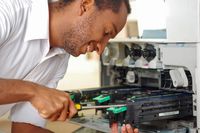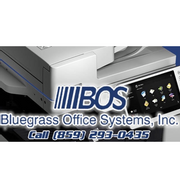4 Photocopier Parts You Should Be Familiar With

Invented by patent attorney Chester Carlson in 1938, the copier has been an office staple ever since. A machine that relies on the underlying physics principle of opposite charge attraction, photocopiers feature several vital components to create document duplicates. Take a moment to learn about these parts and the common issues they face to schedule timely office equipment repair or replacement services.
4 Copier Parts & What They Do
1. Photoreceptor Drum Or Belt
The cylindrical photoreceptor drum is covered in a semiconductor material such as silicon or selenium and undergoes electrostatic charging from high-voltage wires. The semiconductor material transforms into conductive material following light exposure. Light allows the machine to attract toner on a selective basis to make document copies. The paper used for copying also receives an electrostatic charge that attracts the toner and creates the new document.
If the drum blade malfunctions due to wear or another reason, streaks and other blemishes appear on the copied paper. Using the wrong toner for the specific model will also affect print quality. And while the drum may require replacement, if the issue is toner-related, switching to the right product should suffice.
2. Corona Wires
These wires provide the  electrostatic voltage necessary to charge the copier drum. One wire is found parallel to the drum surface to provide a positive charge, while the other coats the paper’s surface as it transfers to the drum.
electrostatic voltage necessary to charge the copier drum. One wire is found parallel to the drum surface to provide a positive charge, while the other coats the paper’s surface as it transfers to the drum.
When corona wires don’t receive regular cleaning, they become coated in dust and grime and create streaky documents. Clean the inside of your copier every few months to avoid this print quality issue.
3. Toner
Also known as dry ink, toner is a pigmented, negatively-charged liquid that sticks to larger, positively-charged beads inside a cartridge. When these beads get rolled over the drum, the smaller particles attach to the drum’s positively-charged ions and subsequently electrostatically-charged paper, resulting in the creation of new documents.
In addition to using the wrong toner for your model, toner issues can occur due to manufacturer errors and require replacements over repairs.
4. Fuser
As the copier delivers toner to the paper, it undergoes a fusing process to create clean, blotch-free documents. The fuser component is responsible for this task, as it melts and presses the toner onto the page. It uses Teflon rollers that eventually jam or stick from a worn feed, resulting in wrinkled pages. Replacing the feed and keeping the fuser clean prevents these and other print quality problems. If the fuser does not receive regular cleaning, it will wear out from the dust and require replacing.
Keep your copiers and other office equipment in excellent condition with repair services from Bluegrass Office Systems. The Lexington, KY, based business has provided Fayette County and central Kentucky clients with state-of-the-art office equipment since 1981 and offers repair services in addition to a wide product selection. Call (859) 293-0435 today to schedule service or learn more about available products online. Get equipment troubleshooting tips on Facebook.
About the Business
(9 reviews)
Have a question? Ask the experts!
Send your question

